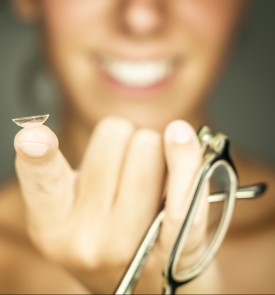7 Benefits of KAMRA Inlays
-

Do you rely on reading glasses or contact lenses because of poor near vision? Are you frustrated with their use and looking for a permanent alternative? Introducing the KAMRA inlay, the first FDA-approved corneal inlay for vision correction surgery in the United States.
Corneal inlays — also called corneal implants — treat a common age-related vision condition called presbyopia. This condition affects near vision making it difficult to read things up close, such as a book or computer screen. Although KAMRA is the only corneal inlay currently available in the U.S., there are others in the investigational stage of development. But for now, KAMRA is the only corneal inlay option and it’s getting a lot of positive buzz. In fact, it was recently featured on a segment of Good Morning America.
If you’re someone who is constantly misplacing or breaking your reading glasses, sick of the hassles associated with contact lenses, or simply looking for a near vision correction change, then KAMRA might be for you.
Here are seven facts about KAMRA Inlays you should know:
-
1. Are You a KAMRA Candidate?

KAMRA is intended for people between the age of 40 and 60 who have poor near vision, but good distance vision (presbyopia). There are a variety of factors that may inhibit your eligibility for KAMRA inlays, such as whether you have had cataract surgery, suffer from dry eye syndrome, glaucoma, diabetes, macular degeneration, have experienced a recent change in distance vision and certain medications (to name a few).
To determine whether you are a candidate for KAMRA inlays, you should speak with an ophthalmologist. But in the meantime, you can head over to the AcuFocus site and check your suitability.
-
2. Minimally Invasive Placement

The KAMRA placement procedure is minimally invasive and requires approximate 15 minutes to complete. Comprised of a 3.8 mm diameter black film-like ring with a 1.6 mm diameter opening in the center, the tiny implant is smaller and thinner than your standard contact lens and weighs less than a grain of salt. It is surgically placed over the center of the pupil several layers into the cornea.
The outpatient procedure is performed in the comfort of your eye surgeon’s office and does not require any stitches. Recovery times vary and will be discussed during your consultation.
-
3. One Eye Only

Unlike some other ocular implants, the KAMRA inlay is only implanted in one eye; the non-dominant eye. This is essential in catering for both near and far vision without the use of glasses or contacts. While both eyes are responsible for distance vision, it is the non-dominant KAMRA-implanted eye that improves near vision.
-
4. It’s Reversible

One of the best features of anything is being able to change your mind and revert back to the way things were. The KAMRA inlay is completely reversible, meaning that the inlay can be surgically removed and you can go back to relying on reading glasses and contact lenses to improve near vision.
During clinical study, vision returned to the same level as it was prior to implantation for most patients. However, AcuFocus does note that this return is not guaranteed. It is possible that patients may experience some level of degraded vision.
-
5. Better Computer Vision

If you have presbyopia you may frequently fight the urge to hunt down your reading glasses or put in your contact lenses when working on your computer, tablet or even your mobile device. This can result in eye strain that can lead to a condition called computer vision syndrome (CVS), or digital vision strain. KAMRA patients who improve their near vision will achieve improved computer vision that will help remedy many of the effects of CVS.
-
6. There are Risks (…There Almost Always Are)

The KAMRA inlay procedure is a safe, FDA-approved, minimally invasive surgery. But like any surgery, there are risks. At the top of that list is the chance that the surgery may make your vision worse than it was prior to surgery. (Fortunately it is a reversible procedure for such rare instances.) Some of the additional risks associated with KAMRA inlays include:
- Decreased contrast sensitivity
- Glare, halos, poor night vision, blurry vision, color disturbances, dryness, double vision
- Infection
- Corneal scarring, clouding, infection, swelling
- Cataract development in the implant eye
- Increased ocular pressure
- Distance vision problems
If you are concerned about any of the potential risks associated with KAMRA inlays, speak with your ophthalmologist to discuss your unique risk factors in greater detail. But keep in mind that the surgery is FDA approved and considered to be very safe.
-
7. There are Alternatives

If you’re not a KAMRA candidate or you simply aren’t interested in a corneal inlay option for treating your presbyopia, you do have alternative treatment choices.
Bifocal, trifocal and progressive glasses can cater to prescriptions that cover multiple distances. This can help improve your near vision while also catering to your distance vision.
Monovision with contact lenses can similarly help manage your near and distance vision by having one prescription contact lens for near vision, and another for distance vision.
Conductive Keratoplasty (also called NearVision CK) is another option for treating presbyopia. A probe guides radio wives to specific spots on your cornea to reshape it and correct near vision. This procedure does not involve a laser or cutting of any kind.





